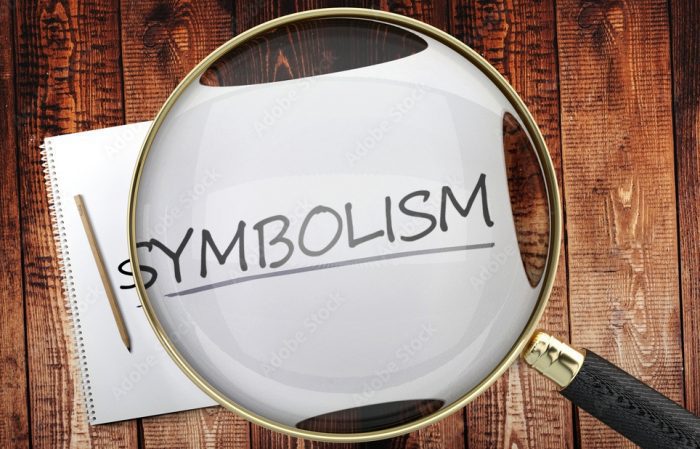The most efficient way to add depth and significance to a story is through symbolism. It serves as a connecting point between the theme and the plot. When used in isolation, articles can be preachy, and tales can be shallow. Both are linked via the employment of symbols.
Instead of telling your story over, utilize pictures to show your audience what happened. It is feasible to explain complicated thoughts in a few words using symbolism. Symbolism can be used to generate the same impact as a succession of photos.
A symbol is worth ten times as many words as an image. The most crucial purpose for using symbols is inspiration. You may need to conduct preliminary research to get your creative juices flowing, and you may need to spend hours creating a cast of characters for each scenario.
If you don’t know how to use symbolism in writing, keep reading this post, and you’ll be able to incorporate symbols in your writings right away.
How to Use Symbolism in Writing
As the reader interprets your words, you encourage them to think for themselves by employing symbolism. Your readers will appreciate having something to think about when they finish reading your piece. It’s a beautiful surprise!
Having learned why symbolism is important, let’s discuss how to include it in your next novel.
Using Universal Symbols to Give Meaning to Your Story
Universal symbols have universal appeal; people of many cultures, eras, genders, races, and religions may identify with them. We are drawn to these symbols in the first place because we automatically make associations between the thing and the thinking or idea it represents.
In some circumstances, readers will deduce the meaning of a symbol simply by looking at it. Doves, water, and storms, among many others, can all be used as a sign of peace. Too many universal symbols, on the other hand, can come across as clichéd, making your message less remembered.
Adding Visuals to The Subject Matter
Through the use of good visual storytelling, a more powerful message can be conveyed. It improves the inventiveness, modernity, and reader-relevance of stories.
With a visual story, you’re writing with images in mind rather than telling. Graphs, charts, and photographs are examples of visual aids that can be used to clarify or complement the written word. An illustration in a story about arduous standard core testing, for example, gives the sensation of being locked in a classroom forever.
A Symbol’s Deeper Meaning
Authors can use symbolism to make their messages more memorable by giving actions, objects, and even names new meanings. Symbolism is the art of attaching something physical to something else to provide it with a new and more significant.
Signs, gestures, objects, and words are all symbols that assist people in understanding their surroundings. They aid in the interpretation of our experiences by providing universally acknowledged meanings.
The principles of a story should be accurately conveyed through symbols, so they must be carefully chosen.
The symbolism of a Smaller Scale
In a given scene or moment, you can use subtle symbolic references. This sign is unlikely to reappear in the plot, but it serves a vital purpose at a specific point in time. There’s no need to prepare ahead of time when writing a small-scale symbol because it won’t be used again in the future.
To represent the character’s tears running down their face, you can use a waterfall as a symbol. Allow your content writing to incorporate these small-scale symbols naturally. To affect the subconscious mind, they need to be almost invisible to the reader.
As long as you’re careful, you don’t want to overwhelm the reader with symbolism. The symbol’s purpose is to draw the reader deeper into the story, not to draw them away from it.
The symbolism of a Large Scale
Many stories contain a recurring symbol that serves as a constant reminder of the story’s theme. It’s known as a “central metaphor” or a “motif” in literary language. The story’s theme is often supported by repeating symbols that help to develop the story’s overall message.
These can occur naturally but are more commonly the result of a well-thought-out strategy. If you’re starting a story, think about the overall theme and whether or not you want to use any powerful symbols to further the meaning.
While working on an upcoming book, I noticed that water frequently appears as a metaphor for transition. As the tides change, so do the waves, causing the water to shift in position. This refers to the protagonist’s feelings and the events around them in various scenes.
Use Symbolism to Add Emotional Resonance
Symbols can leave a lasting impact on a reader by adding emotional resonance to a story. In William Shakespeare’s Macbeth, Lady Macbeth’s guilt-ridden is afflicted by a smear of blood on her hands that would not wash clean after killing King Duncan.
This bird is a symbol of sadness and anguish in Edgar Allen Poe’s novel The Raven. The symbolic meaning is embedded in these English literary works, giving them emotional weight and value.
How Does Symbolism Help
Symbols Help Readers to Imagine
With the help of symbolic representation, simple ideas can be given a visual boost. The novel “The Lord of the Flies” by author William Golding is an excellent source for symbolism in literary images. A conch shell represents power and order in the Garden of Eden, a pig’s head represents absolute evil, and an island symbolically.
Symbols Hint at Darker Meanings
Symbols are used in stories to express a gloomy and realistic meaning. You could utilize symbolism to teach your readers about life, love, and friendship, for example.
As an example: His daughter Pearl reflects the alleged transgression that caused her birth in Nathaniel Hawthorne’s “The Scarlet Letter.’’ Pearl’s severe demeanor reflects her father, Reverend Arthur Dimmesdale, and symbolizes the mystery of her existence.
As illustrated in the preceding example, you could construct things and give them a darker meaning to assist your story’s progress and develop a theme.
It Aids in The Comprehension of The Material
Symbols can be used to aid and connect thoughts or concepts. Some ideas are better left unsaid because they can be tiresome for both the author and the reader, which you don’t want to do.
It’s a good idea to have some fun with your writing and help your readers understand complex topics and excitingly follow critical themes. Your character may wake up ready for a new beginning following a late-night breakup dispute. It’s enough to remark, “Sarah was excited to start afresh.”
When beginning a new project, symbols, such as an early sunrise or fresh linens on the bed, might serve as a reminder of a new beginning.
Defining Your Story’s Central Concept
What makes a narrative worthwhile to read is that it deals with a severe or disputed issue which is a good notion, but confronting it can be challenging at times. Instead, use symbols to help your readers understand your message.
Enhances Your Story’s Depth and Realism
Emotional weight should be added to the words by a symbol’s visual representation. If you use characters correctly, you may transmit an enormous amount in a short time and elicit tremendous feelings in your reader.
We all have our unique perspectives on the world around us. If you go to a museum and look at a painting, I love to imagine how other people see different shapes, colors, and emotions. Regardless of what the artist intends, you will experience it in your unique way. Read more: How To Write a Prophecy
Types of Symbolism
There are various ways to use symbolism, whether it’s in literature or ordinary conversation. To better understand symbolism, it’s essential to know the differences between multiple types of symbolism. Here are some examples of symbolism in action:
Irony
To express something other than and especially the antithesis of the literal meaning by employing a word or phrase. Comedy and irony are often used together in the same piece of writing. The irony is a literary device used to engage the audience while also deepening the plot.
Metonymy
A figure of speech uses one item’s name for another to which it is an attribute or is linked. One thing or notion can be substituted for another object or concept by employing a related term known as a metonym. Metonymy is often used in both literature and everyday life. You’re probably doing it unintentionally already. Make a mental note of the purpose of metonymy.
Metonymy can be found in various circumstances, such as The administration of the President of the United States is referred to as the White House or the Oval Office. The American technical industry is referred to as “Silicon Valley.” The American advertising sector is referred to as “Madison Avenue.”
Hyperbole
Hyperbole is a figure of speech that involves using extreme exaggeration to convey or accentuate a message. In this context, overstatement is the polar opposite of understatement. Examples of hyperbole can be found in both literature and everyday conversation.
Hyperbole is used in literature, rhetoric, and everyday speech. Nonfiction works, such as reports or research articles, would be unaffected by its use. This is a beautiful tool for creative writing and communication if you want to add color or humor to a character or a story.
Personification
Personification is a figurative language in which an object or idea is given human features and sentiments. We utilize the personification metaphor to give non-human entities human characteristics. Writers can turn inanimate things, animals, and even abstract ideas to life by attributing recognizable human behaviors and feelings. It is conceivable for a writer to make a point by depicting non-human creatures as having a personality.
Archetype
An archetype is a type of character in literature that the reader can recognize based on a specific set of features. Carl Jung derived the archetype from his studies into the collective unconscious or remembrance of universal occurrences. Characters in literary works are commonly referred to as archetypes because they embody universal human experiences and emotions that transcend time and geography.
As an example, consider the Hero, a well-known literary archetype. A hero is defined by several characteristics, including courage, perseverance, sacrifice, and the capacity to overcome adversity.
Allegory
Using a character, event, or place, an allegory conveys a more meaningful message about something happening in the real world. One way to look at this type of narrative is to say it’s a story in which most characters and plot developments are symbols for something else or that the story itself reflects a broader occurrence in the real world.
Characters and events are used rather than words to convey a hidden meaning or message. An allegory is a metaphor, and symbolism in general, extended to a greater extent.
Metaphor
A metaphor is a means to relate two very distinct things. When a metaphor is not followed by the words “like” or “similar,” it might lead to misleading comparisons. A metaphor can be used to represent the idea that two things are identical. A specific literary device is the use of images or concepts to convey abstract ideas.
One of the most famous literary metaphors is Romeo and Juliet’s “What type of light is coming through the yonder window?” The sun is rising in the east, Juliet. In this metaphor, Juliet is compared to the sun.
Why Writers Like to Use Symbolism
It’s nearly impossible to find a piece of literature that doesn’t have some form of symbolism in it. Symbolism is a popular tool for authors because it accomplishes the following:
- Aids in the comprehension of complex concepts and the identification of recurring themes
- Allows writers to convey complex ideas in a concise, visually appealing manner
- As the book progresses, the author encourages the readers to think for themselves
- Interpretation of the author’s work
- Increases the emotional impact of the text
- It helps to hide a topic that may be too sensitive to discuss openly
Conclusion
Symbols are an excellent way to help your readers visualize the story you’re telling in your writing. If the story is more complicated, it can also help the reader understand it. Symbolism heightens the emotional effect of a piece of paper and helps readers remain involved in the story’s reality.
We hope you now understand what symbols imply and how to use symbolism in writing. We recommend that you utilize as many symbols as possible in your writing to determine which ones work best for your story and significantly influence readers.



